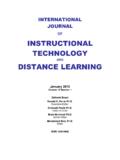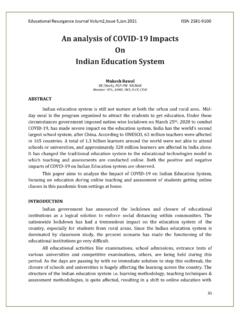Transcription of THE MOTIVATION TO LEARN ONLINE QUESTIONNAIRE
1 THE MOTIVATION TO LEARN ONLINE QUESTIONNAIRE by Shawn Fowler (Under the Direction of Stacey Neuharth-Pritchett) ABSTRACT The goal of the current study was to develop and to validate a research instrument to assess college students MOTIVATION to LEARN ONLINE . Considerable research has been done on MOTIVATION to LEARN in traditional classrooms and several instruments to assess MOTIVATION in those environments exist. One such instrument is the Motivated Strategies for Learning QUESTIONNAIRE , upon which the present research is partially based. MOTIVATION to LEARN ONLINE is not as well-researched and, with the increasing prevalence of ONLINE courses, a better understanding of the role of MOTIVATION in the ONLINE classroom is needed. A valid, reliable instrument to assess MOTIVATION in ONLINE environments will provide instructors with a powerful tool for creating and assessing optimal ONLINE educational experiences.
2 A MOTIVATION to LEARN ONLINE QUESTIONNAIRE (MLOQ) has been developed to assess college students MOTIVATION to LEARN in ONLINE classes. This instrument was administered to 160 students in courses taught ONLINE at a large public university. Confirmatory factor analysis was performed on the responses to determine if the hypothesized motivational factors explain the shared variance in the items that are intended to measure pre-defined factors. Additionally, reliability estimates were calculated for the items in each subscale to determine whether those items measure the same construct. Regression analyses were performed to determine if there were relationships between the demographic data and the survey data. The subscales of the MLOQ exhibited high reliability coefficients, however the proposed theoretical model did not fit the data.
3 Gender differences were observed in overall MOTIVATION , extrinsic goal orientation, and social engagement, with women scoring higher than men on each of those subscales. INDEX WORDS: MOTIVATION , ONLINE learning, Self-determination theory, Autonomy, Competence, Relatedness, MOTIVATION to LEARN THE MOTIVATION TO LEARN ONLINE QUESTIONNAIRE by Shawn Fowler , The University of Georgia, 2000 , The University of Georgia, 2007 A Dissertation Submitted to the Graduate Faculty of The University of Georgia in Partial Fulfillment of the Requirements for the Degree DOCTOR OF PHILOSOPHY ATHENS, GEORGIA 2018 2018 Shawn Fowler All Rights Reserved THE MOTIVATION TO LEARN ONLINE QUESTIONNAIRE by SHAWN FOWLER Major Professor: Stacey Neuharth-Pritchett Committee: Shawn Glynn Louis Castenell Laine Bradshaw Electronic Version Approved.
4 Suzanne Barbour Dean of the Graduate School The University of Georgia May 2018 iv TABLE OF CONTENTS Page CHAPTER 1 INTRODUCTION ..1 Emergence of ONLINE Courses ..2 Criticisms ..4 2 LITERATURE REVIEW ..6 Social Cognitive Theory ..6 Self Determination Theory .. 13 Mindset Theory .. 22 3 THE MOTIVATION TO LEARN ONLINE QUESTIONNAIRE .. 25 Control of Learning Beliefs .. 25 Task Value .. 26 Instructor Support .. 27 Social Engagement .. 29 4 METHOD .. 32 Participants .. 32 Instrument .. 33 Procedure .. 36 5 RESULTS .. 37 Reliability .. 37 Validity .. 38 v Demographic Factors .. 39 6 DISCUSSION .. 41 Limitations of the Present Study .. 43 Directions for Future Research .. 44 45 REFERENCES .. 46 LIST OF TABLES .. 59 LIST OF FIGURES .. 61 APPENDICES .. 62 A PART 1 OF SURVEY: DEMOGRAPHIC 62 B SUBSCALES OF THE MLOQ.
5 63 1 CHAPTER 1 INTRODUCTION Since the advent of the Internet and the World Wide Web, ONLINE courses have emerged as a viable form of instruction. Although these ONLINE courses have become a prominent method for delivering instruction, the cognitive and psychological effects of the shift in instructional environment are poorly understood. Factors that are well-documented as influencing the quality of instruction in a traditional classroom might function differently in ONLINE learning environments. Additionally, how motivational factors are considered when determining the optimal approach to ONLINE learning is not well studied. Research indicates MOTIVATION to LEARN plays a strong role in fostering academic success. Motivated students engage with subject matter for longer periods of time, display more persistence when encountered with adversity, and achieve at higher levels than do students who are less motivated (Bandura, 1986; Schunk, 1995).
6 Much of the work on MOTIVATION in learning has been conducted in traditional classroom settings. How MOTIVATION operates within ONLINE learning environments is not as well understood. Does MOTIVATION in ONLINE classrooms differ from traditional classrooms? How can instructors design their ONLINE courses to optimize student MOTIVATION ? How can students identify and take advantage of motivational strengths in ONLINE courses? As ONLINE courses become more prevalent and the understanding of the influence of MOTIVATION in such learning environments becomes more grounded, teachers, researchers, and students need an effective measurement tool to answer these questions and assess student MOTIVATION . 2 Emergence of ONLINE Courses The popularity of ONLINE courses in higher education is growing. A number of factors is contributing to this increased popularity, including the rising cost of providing college education , the rising popularity of higher education , the growing number of nontraditional students (Miltiadou & Savenye, 2003) pursuing higher education , and the increased inclusion of the internet in the daily lives of Americans.
7 Two ways the emergence of ONLINE courses have impacted education are through traditional courses held in post-secondary institutions and Massively Open ONLINE Courses (MOOCs). traditional universities are beginning to embrace ONLINE education . While ONLINE courses began as an experiment in the 1990s, they have emerged from the novelty of the educational fringe to become part of the mainstream in higher education . Today, many major colleges and universities regularly offer ONLINE courses as part of their standard curriculum and a number of universities now offer both undergraduate and graduate degree programs that are conducted exclusively ONLINE . A study conducted by the National Center for education Statistics found that of postsecondary students were enrolled in a distance education course, with enrolled exclusively in distance education courses (NCES, 2013).
8 Courses once taught in lecture halls filled with hundreds of students are now offered ONLINE , allowing students to access learning from the convenience of their homes. Along with collegiate instruction, there is a growing, competitive market for ONLINE education . With traditional universities now invested in ONLINE education , what was frequently regarded as second-rate instruction is becoming increasingly accepted, mainstream, and popular. Massively Open ONLINE Courses (MOOCs) were introduced in 2008 and have risen in popularity since that time. MOOCs are courses designed to be conducted over the Internet and 3 made available to a large, virtually unlimited, number of students. There is a great deal of variation in the way that MOOCs are structured and administered (Kennedy, 2014). Much of this variation is dependent on the organization delivering the MOOC.
9 Currently, there are two primary categories of MOOC providers: nonprofit and commercial. edX is a prominent example of a nonprofit provider. The edX project is a multi-institution collaboration including post-secondary institutions such as MIT, Harvard, and UC Berkeley, among others. Popular commercial MOOC providers include Coursera, Udemy, and Udacity. Commercial organizations create and administer MOOCs for profit. However, many commercial MOOC providers also feature partnerships with academic institutions, as well as working with individuals and businesses to administer courses. MOOCs vary in their instructional design. Lectures range from live sessions conducted by an instructor and broadcasted ONLINE in real-time, to recorded sessions accessed on-demand by students. While some of these courses are offered for credit, many are offered for the learning alone.
10 Often, students pay a fee to receive credit for the course, while it is available for free to noncredit-seeking students. Likewise, there is variation in the ways students interact in the courses. Some courses have real-time discussions monitored by teaching assistants or more advanced students. Many options also exist for coursework. In some courses, coursework is graded by instructors and teaching assistants. In others, students check their work against answers released by the instructor. A common approach in courses offered by academic institutions is that students seeking course credit in degree programs receive grades and feedback, as well as additional graded assignments, while noncredit seeking students do not. 4 Criticisms Despite growing popularity, there are significant criticisms of ONLINE learning. Some researchers have found that the quality of learning outcomes in ONLINE courses is poor when compared with traditional courses (Xu & Jaggars, 2013).










